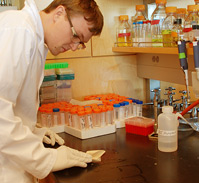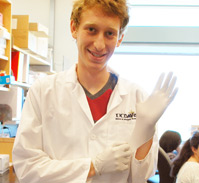Safety
We always made use of protective gear, such as wearing gloves at all times, face masks when using UV lamps, and lab coats when appropriate. All of our waste was autoclaved on site as well, and all tools and glassware thoroughly cleaned after each use.
We worked with ethylene glycol during our experiments, which is toxic to the kidney, liver and central nervous system, as well as a skin and eye irritant. Obviously, we wanted to be very safe when using this chemical, so we made sure to consult with our advisers on how best to handle it. When using ethylene glycol, we always worked under a fume hood and wore lab coats. We had a separate waste bottle for all of the byproducts with ethylene glycol, so that the waste could be treated and properly disposed of.



The University of California at Davis has a biosafety group, which heads the disposal and use of hazardous materials. They approve of our project and the procedures that we have followed. Further, they are excited for the potential that this project has, in terms of making the environment safer for inhabitants.
Our project, when properly functioning, should not have any harmful effect on the environment, researchers, or the public. We keep everything contained within the lab, and all of the plates and wastes are autoclaved to prevent all bacteria we use from spreading to the outside environment.
If we were to implement our bacteria in a landfill, it could not survive past a couple generations and therefore would not be very toxic. However, if we were to imagine a more robust version of our strain created in the future, we would implement a kill switch, which has already been created using synthetic biology, to make sure we could stop it (2). We would also create a system similar to Imperial College London’s Gene Guard, which would stop to plastic-degrading plasmid from getting transferred to other bacteria (3). This would contain the plasmid within only our bacteria, so it would not get out of hand.
Our project could potentially be dangerous if our strain received a pathogenic plasmid by lateral gene transfer from other organisms. However, if this were a concern, our strain would be just a susceptible to pathogenicity as any other. If someone with malicious intent were to use our construct, perhaps the most they could do is release it into the water way and have it degrade plastic pipes made of PET, or modify it to degrade other plastics in addition to PET and degrade something useful. Cutinase, the first enzyme in our degradation pathway, functions optimally at 50° C, and the water in our pipes would most likely not be at that temperature. Also, it is unlikely the strain would survive under conditions such as this temperature and being in an aquatic environment (4).



 "
"











